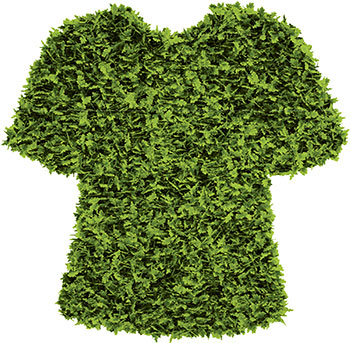
 A Makeup
A Makeup
Brush to Ace Foundation
If you're still applying foundation with your fingers, don't! Beauty pros in the Triangle swear that makeup brushes deliver the most natural and radiant effect. A brush gives your skin full coverage with a flawless, even finish. Plus, it keeps the oil and bacteria on your fingers from clogging your pores.
 Bra Fitting: How to Measure Up
Bra Fitting: How to Measure Up
The very best way to determine the correct bra size for your body is to see a professional fitter at a bra shop in Raleigh or a department store in Durham. But if you're DIY all the way, there's an excellent, if a bit complex, method to determine it yourself:
Wrap a tape measure around your rib cage just under your bust, keeping it tight.
If the measurement is an odd number, add 5 inches. If it's even, add 4 inches. If it's in between, round up to the nearest inch. That figure is your band size.
For cup size, measure around the fullest part of your bosom. Keep the tape loose so as not to compress your chest, and keep the tape flat and even around your body.
Subtract your band size from the cup measurement. Then match the difference to a cup size. 1 inch is an A cup; 2 inches, B; 3 inches, C; 4 inches, D; 5 inches, DD; 6 inches, DDD; 7 inches, E; 8 inches, F; and 9 inches, G.
 Nice (to the Planet) Clothes
Nice (to the Planet) Clothes
Generally, Triangle women like to wear clothes that don't have a negative impact on the Earth. But textile manufacturing is so complicated that it's difficult to know what to purchase. When you must have a new outfit, here's a quick, eco-friendly guide to the four basic apparel fibers, based on reporting in The New York Times.
Oil-based synthetics
Polyester, nylon and their brethren are made from nonrenewable resources. For example, polyester is a plastic derived from crude oil. Synthetic fibers shed plastic filaments that make their way into water systems and the digestive tracts of animals that graze on fertilized plants.
Cotton
Cotton is natural but requires pesticides, and synthetic fibers are often blended with cotton thread. Consumers can choose garments made with organic cotton grown without pesticides, but it can be much more expensive and difficult to find.
Rayon
Rayon is made of plants and chemicals. Viscose rayon, the most common type, is treated with carbon disulfide, which can cause serious health problems for rayon workers and may be released into the environment. Viscose rayon is often made from bamboo, which sounds good. But producers are cutting down old-growth forests to plant bamboo.
Wool
Good ol' wool might be less practical, but it's sustainable. Many experts consider wool to be more ecologically sound than cotton, rayon or synthetic fibers. However, wool comes from sheep, which produce methane, a powerful greenhouse gas.